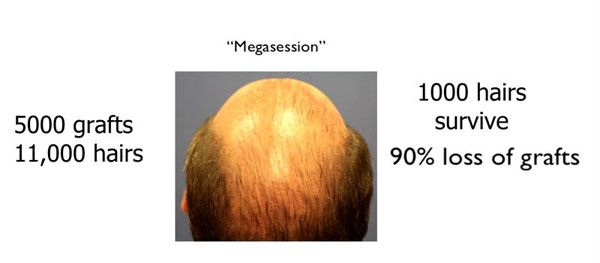Hair Transplants Limitations
Hair transplantation may appear to be the best solution for people losing their hair. To many others, it brings to mind images of unattractive hair plugs. To many men who have gone through hair transplant, it evokes thoughts of disappointment and frustration. Why?
- By not achieving the results they wanted
- Expensive repeat sessions
- Continued loss of hair that they invested so much money to have implanted.
According to the International Society of Hair Restoration Surgery (ISHRS) practice census, of men who’ve had hair transplants, 64% were disappointed with their hair density after their procedure.
Limitations of Hair Transplants
- Limited donor hair for transplant: Limited amount of hairs genetically resistant to hair loss in the donor area.
- Hair transplant for thinning hair doesn’t stop progression: Particular to follicular unit extraction (FUE) surgery, donor hairs can be taken from outside the genetically resistant area which will continue to thin and eventually be lost
- Insufficient coverage for large bald areas: Large bald areas that patients desire to have covered cannot be transplanted to full coverage
- Insufficient density of transplanted hair
- The need for repeat hair transplants due to continued hair loss (Hair transplant does not stop hair thinning).
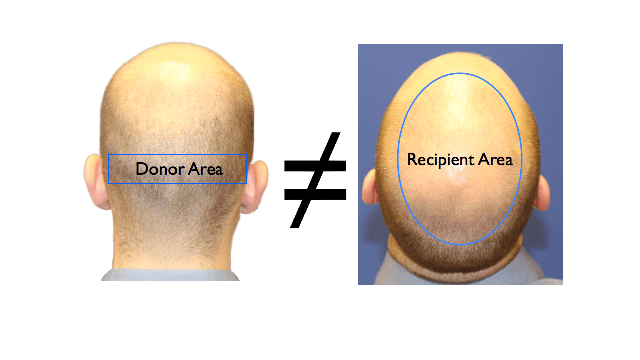
The amount of genetically resistant donor hair at the back of the head is usually much less than the hair lost at the top of the scalp and the crown.
Why Hair Transplants Don’t Stop Hair Loss
Perhaps the biggest problem that hair transplants do not address is that the procedure does not actually treat the cause for hair loss. Hair loss is not the result of hair disappearing suddenly: it first manifests as hair growing thinner each time a hair sheds and enters the growing phase. The hair with every cycle continues to miniaturize, and then disappears.
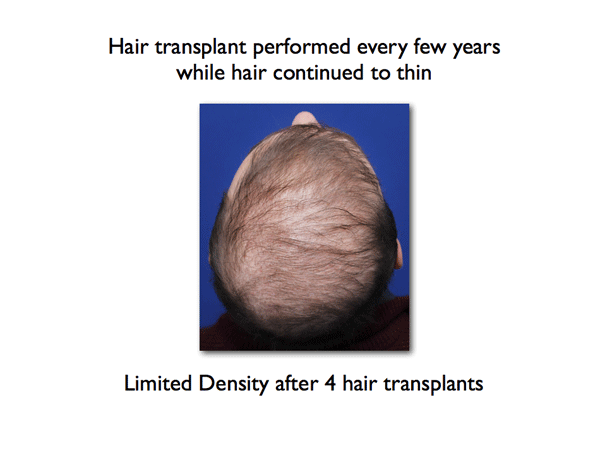
Even after 4 transplant sessions over several years, hair continues to thin and be lost. The amount of donor hair available can not keep up with the amount of hair that thins and eventually disappears due to male pattern hair loss
One known factor responsible for male pattern hair thinning leading to hair loss is caused by the conversion of the hormone testosterone to dihydrotestosterone (DHT). While the primary cause of female pattern hair loss is still not quite known, inflammation which leads to dysfunction of the hair follicle is considered a factor responsible for hair thinning in women.
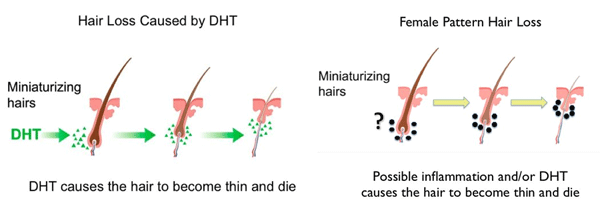
The cause of male pattern hair thinning and hair loss (left) and the possible cause of female hair thinning (right)
Since hair transplants do not have any effect on hormones or the cells and signals that trigger hair growth, they do not treat the cause of thinning hair that leads to hair loss. Unfortunately this means the benefits of a hair transplant can be limited depending on the pattern of your hair loss. If a hair transplant is not supplemented by appropriate medical therapy such as:
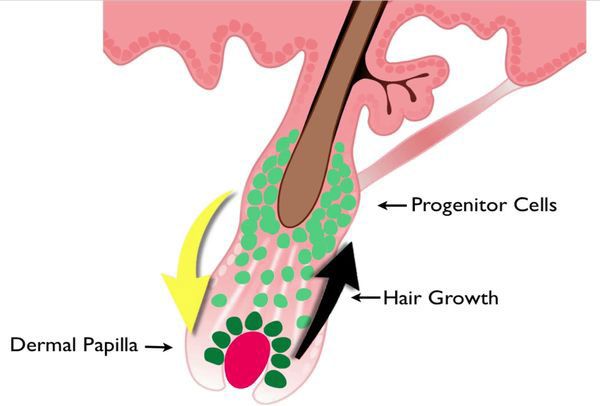
The hormonal cells and signals that trigger hair growth. Hair transplantation has no effect on this chemical communication
- Finasteride (DHT protector, pill – limited to a percentage of males)
- Minoxidil (topical, hair growth cycle extender topical)
- Hair Regeneration (stem cell catalyst, injection)
Your hair will continue to thin until it’s lost altogether. This means a hair transplant procedure will need to be repeated for sustained hair coverage, but this can only be done if there is hair available for transplant in your donor area.
Evidence of Transplants not Stopping Hair Loss
The signature sign of a “bad hair transplant” is often seen when there are small concentrations of hair growing out of bald scalp. This phenomenon is is often referred to as “hair plugs” or the “pluggy look” “. This undesirable look is not actually caused by the hair transplant procedure itself but rather the continuous loss of native hair.
Essentially, as the transplanted hairs continue to grow, the native hair around it continued to thin, miniaturize, and eventually disappear. Thus, even a successful hair transplant will not stop the thinning and eventual loss of native hair.
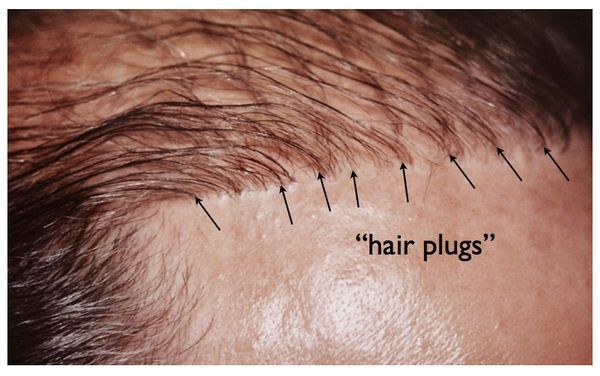
Hair thinning that continues after a hair transplant leaves genetically resistant transplanted hair behind, while the native hair around it thins and eventually disappears, leading to visible “hair plugs”
Limitations of the Donor Area
Hair genetically resistant to hair loss only grows in a limited area in the back of the head. If you think of a very bald man, you understand the “handle bar” of hair remaining in the back is genetically resistant to further hair loss. Any hair taken above or below this area is susceptible to loss after transplant or as part of progressive hair loss.

The safe, genetically resistant to hair loss donor area is much smaller than the scalp where hair tends to be lost in male pattern hair loss, highlighting the inherent limitations of hair transplants.
Considering that hair taken from a small area has to cover such a large area of baldness at the front of the scalp and the crown, spreading out the limited amount of hair would mean sacrificing natural-looking hair density. A successful harvest of donor hairs is usually between 2500-4000 individual hairs. When a person first notices hair loss, they have already lost half the hair on their head, which once totaled about 100,000 in their early teens. With 2500-4000 hairs to cover an area that has lost 50,000 or more hairs, it is clear that there is a mismatch between the small donor area with large recipient site. This leads to two other big limitations of hair transplants:
- A natural-looking hair transplant density cannot be achieved in a single session.
- Patients insistent on density results leads in hairs being harvested outside the safe donor area, which are prone to hair thinning and loss.
Hairs Taken from Outside the Safe Donor Area
Hairs are often taken outside the safe donor area in a popular harvesting method known as follicular unit extractions (FUEs). This risk is equally present with so called “high tech” procedures such as robotic extractions. FUE is a very common method of hair transplantation in the industry today.
For many years, the “strip method” or FUT (follicular unit transplant) was the standard approach for hair transplant. Unfortunately, due to poor communication and improper surgical technique, the procedure resulted in many patients having undesirable scars. Follicular unit extractions were first thought to relieve patients of the scars associated with follicular unit transplants (FUTs). Advanced careful patient selection, wound healing technology and properly performed surgical closure has enabled the more reliable, predictable, and higher yield FUT to evolve. FUEs still create scarring and in fact creates more scarring than the FUT method. In addition, FUEs often require hair to be harvested from outside of the safe donor area.
This is unlike FUTs where hair is harvested only from safe donor area only. The bottom line is that hairs taken outside of the safe donor zone are prone to the same hair thinning and eventual pattern hair loss problems experienced at the scalp or the crown. While using these hairs will contribute to a short-term gain of more hairs available to transplant, in the medium and long-term, these grafts will thin and disappear.
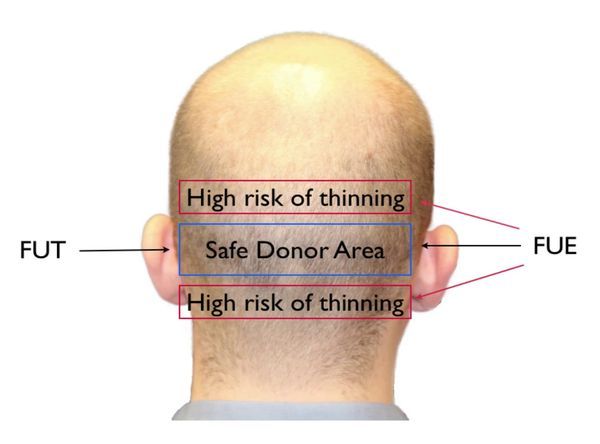
The hair graft donor sites for the FUT and FUE. While the band of hair used in FUTs are genetically resistant to hair thinning, the wider area used in FUEs are at a high risk of thinning when transplanted.
Natural hair thinning of native hairs combined with transplanted hairs that are prone to hair thinning results in isolation of genetically resistant transplanted hairs which is responsible for the “pluggy look”.
Transplant Density is Limited
People suffering from hair loss want a natural density of hair during a transplant, and most want it done in a single session. However, only a limited amount of hair can be safely and effectively transplanted per square centimeter of the scalp. Transplanted hair also consists of the shaft and the entire follicular unit including the dermal papilla and other soft tissue. In order for the follicular unit to survive and grow, it will need space on the scalp for an adequate blood and nutrient supply from the body.

Only so many hairs can be placed safely in the first transplant session, so a second or more transplants are needed later on to achieve natural looking density
Crowding transplanted hair puts the transplanted hair and native hair at risk. Transplanting too many hairs per square centimeter limits the amount of blood supply needed for hair grafts to survive and thrive. Hair transplanting also causes trauma to existing native hairs. In short, exceeding a safe transplant density may result not only an ineffective hair transplant, but having less hair than before the transplant since native hair may also be lost.
How Desired Hair Density Compromises Doctors and Patients
The desire for high hair transplant density can put hair transplant doctors and patients in compromised positions. With statistics from the ISHRS where 64% of patients after hair transplant are unhappy with hair transplant density, its no surprise that patients want greater density and more grafts. Many hair transplant doctors, particularly FUE practitioners, charge per graft which means more grafts mean higher surgical fees. Placing many grafts with a high density are what many patients think they need, and there are plenty of hair transplant doctors willing to provide them.While placing many grafts may sound like an ideal solution, and many doctors will promise more transplant density than others, these grafts are not likely to survive. Patients may be happy when they hear about high hair density count and sheer amount of grafts (reaching 10,000 grafts as session) known as “mega sessions”. However, with potentially up to 90% of grafts from mega sessions eventually lost, patient satisfaction is often not achieved as many grafts die before they can grow significantly.
Why Hair Transplants are Not a One Time Procedure
When you look online, many people are asking about hair transplant. What many hair loss sufferers don’t realize, and what many hair transplant doctors do not disclose immediately, is that there is a high likelihood that two or more hair transplant procedures will be needed. The main reasons for a need for repeat hair transplant sessions are:
- The patient’s natural, native existing hair will continue to thin and be lost. The transplanted hair from the safe donor area won’t thin but the hair that is still in the thinning area will continue to miniaturize and eventually disappear. If you don’t have another hair transplant, then you can be at risk for the “pluggy look” since the transplanted hair will remain isolated on bald scalp.
- A “natural-looking” transplant density cannot often be achieved in a single transplant session because only a limited number of grafts can be placed in a given area to ensure survival. A hair graft needs a zone of blood supply for healing and continued growth. Trying to exceed the limit of a safe number grafts puts valuable hair grafts at risk of being lost. Exceeding the safe number of grafts per section of scalp in a single transplant session also puts adjacent native hair at risk of loss due to trauma. Achieving natural-looking density comes through a second or multiple transplant sessions.
- The donor area is limited as only 1500-4000 grafts can be harvested safely in single transplant session. Any grafts outside the safe donor zone will yield hairs that are likely to thin and be lost eventually. To ensure grafts survive and grow, a limited number of hairs can be transplanted and the donor area needs to heal before you can have another procedure.
How to Maximize Hair Transplant Results
There are ways to maximize hair transplant results, which include medical therapy and stem cell based treatment.
1. Finasteride Oral Medication
For men, taking the pill finasteride (brand name Propecia) inhibits the enzyme 5-alpha reductase that causes testosterone to convert to dihydrotestosterone (DHT). DHT is a significant factor causing hair thinning in men with DHT sensitive hair. Continued use of finasteride can help in slowing down hair from thinning. Unfortunately, finasteride does not work the same in all men, and there is increasing concern of its long-term sexual side effects. Many men are refusing to take finasteride due to this concern. Finasteride must be taken regularly for efficacy.
2. Minoxidil Topical Application
The topical treatment minoxidil (brand name Rogaine or Regaine) can be used by men and women as a liquid or foam. Minoxidil acts by extending the growth phase of hair (anagen phase) and delaying the shedding and resting phase (telogen phase). While hair thinning is not stopped, more hair remains on the head before shedding, giving greater density and hair coverage.
Minoxidil will not thicken hair or prevent hair from thinning, but since it does delay the onset of the resting phase where hair gradually thins, it does also delay the hair thinning process. While minoxidil can be used by both men and women, not everyone responds to it. Minoxidil must be used continually to sustain effectiveness.
3. Hair Regeneration Injection
Hair Regeneration was developed by Dr. Amiya Prasad to thicken existing hair and help manage progressive hair loss. It is an injection treatment comprised primarily of extracellular matrix by ACell, Inc. and platelet-rich plasma, which are both wound healing materials. Its wound healing properties appear to trigger adult stem cells to restart the cells and signals in the body needed for continued hair growth.
It also includes vitamin D which has been shown in laboratory studies to improve hair growth. While Hair Regeneration can be an alternative to hair transplantation in younger patients by thickening thinning hair and helping hair loss progression, it is also used in hair transplants to improve graft survival. Hair Regeneration’s ability to manage progressive hair loss and thicken existing hair can in many situations displace the need for additional hair transplants when implanted hair is lost, and native hair has thinned or disappeared.
Hair Regeneration can be applied:
- Before deciding on a hair transplant procedure by thickening and helping existing hair first
- During a hair transplant to increase graft survival and improve results
- After a hair transplant to increase graft survival, thicken hair, and manage future loss.

Hair Regeneration is applied to a male patient who has never had a hair transplant. Results are from non-surgical injection treatment only
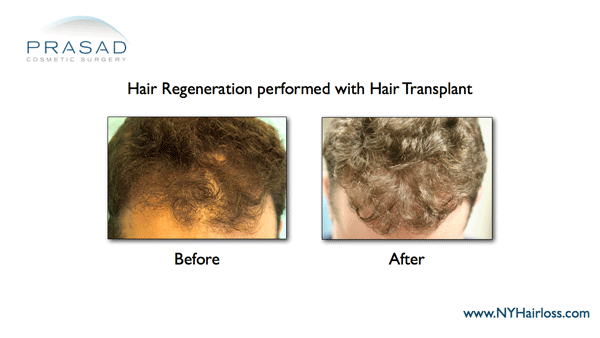
Hair Regeneration was applied one month after the patient had a hair transplant at another practice. Native hair was thickened, and survival of implanted grafts were improved to achieve higher density, while progressive hair loss is stopped so future transplants won’t be needed
Hair Regeneration has been successful in 99% of men and women in the past 7 years. For many patients, Hair Regeneration after a single time treatment appears to last 2 to 5 years, and beyond. Individual hair loss profiles do vary based on age of onset, rate of progression, and degree of hair loss. Some people do not respond to Hair Regeneration.

